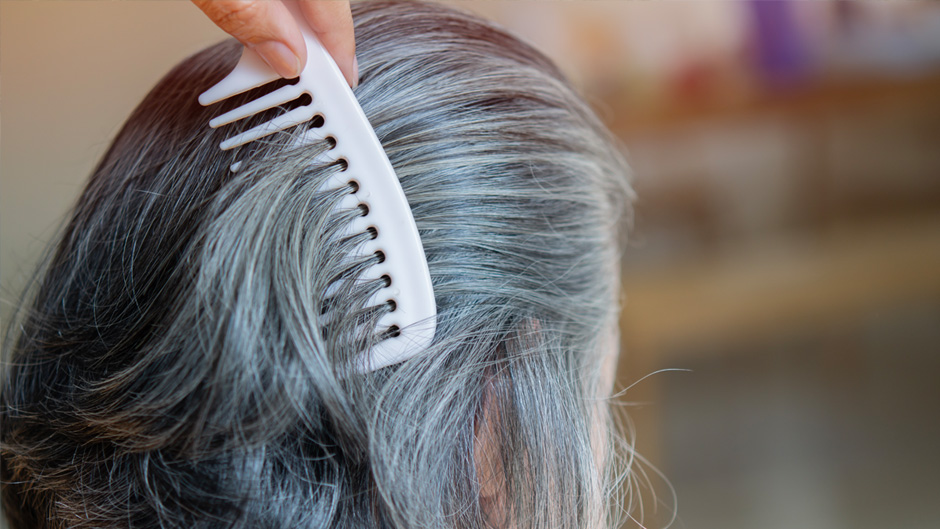In the quest for timeless beauty, one of the most inevitable signs of aging—gray hair—often prompts both curiosity and concern. But what exactly causes our once-vibrant hair color to turn gray?
Many people may notice their first gray hair in their 40s, or even 50s. But for some, gray hairs can appear as early as their 30s, according to Dr. Antonella Tosti, a UHealth – University of Miami Health System dermatologist and Fredric Brandt Endowed Professor of Dermatology and Cutaneous Surgery at the Miller School of Medicine.
While several factors may determine at what age and how quickly people grow gray hairs, many want to know—is it forever? Dr. Tosti provided insight on some of the questions regarding what causes our luscious locks to go gray.
What's the science behind why we get those pesky gray hairs?
Graying occurs as part of the aging process. Hair turns gray when the pigment-producing cells in the hair follicles, known as melanocytes, gradually reduce their production of melanin, the pigment responsible for hair color. This change is typically visible around age 30 for Caucasians and closer to age 45 for Black individuals, but these age ranges can vary based on genetic factors. Environmental influences also play a role; factors like pollution, smoking, and overall lifestyle can contribute to oxidative stress, accelerating the graying process.
Stress has been linked to faster graying because it impacts the melanocytes, further reducing pigment production. Hair follicles have melanocytes only during the active growth phase; once the follicle enters the resting phase, melanocytes disappear. Over time, we believe the reservoir of stem cells that refill these pigment-producing cells may diminish, leading to gray hair. There are instances where gray hair can revert to its original color. We’ve seen this with certain cancer treatments, suggesting that graying might not be entirely irreversible in the future.
Are there any recommendations for someone experiencing premature graying?
For those dealing with premature graying, several things may help manage or slow down the process. Protecting your hair from excessive sun exposure is one way, as UV rays can accelerate graying. Incorporating antioxidants into your diet can also be beneficial. Products containing pseudocatalase, which is an ingredient that may improve or prevent a little bit graying. Maintaining a healthy lifestyle, including a balanced diet rich in vitamins and minerals, and avoiding smoking are essential. Research has also shown a correlation between low vitamin D levels and premature graying, so ensuring adequate vitamin D intake could be helpful.
What is the science behind changes in hair texture as we go gray?
As hair turns gray, it often becomes thicker and coarser. This change in texture is due to the loss of melanin and alterations in the structure of the hair shaft. Gray hair tends to be more brittle and less smooth compared to pigmented hair. When you color your hair, it can also impact its texture, often resulting in a loss of shine and overall quality. Proper hair care is crucial to manage these changes. After dyeing, it's important to thoroughly shampoo your hair to remove any residual dye that could lead to scalp irritation or other issues. Regular conditioning is also essential to maintain hair health and prevent damage. It is important to note that bleaching, which lightens hair, significantly weakens and thins the hair shaft, making it more susceptible to breakage. Therefore, understanding the differences between dyeing and bleaching is important for maintaining hair integrity.
Are there any trendy anti-gray products you would recommend?
There are several trendy products claiming to combat gray hair, including various vitamins and supplements. Antioxidants, which help combat oxidative stress, are beneficial for overall health and may support hair health. Some products contain pseudocatalase, an enzyme that might help reduce oxidative stress, although strong scientific evidence for its effectiveness in reversing gray hair is still lacking. While these products may offer some benefits, it's important to approach them with realistic expectations and focus on overall hair health through a balanced diet and lifestyle.
What does the future of gray hair look like?
Research into reversing gray hair is ongoing, with many cosmetic companies investing in developing effective treatments. While some cases of hair regaining color have been documented, the science is still evolving. The hope is that future advancements will provide better solutions than current hair dye options, offering more effective ways to manage or potentially reverse graying. As research progresses, we may see new treatments that could make dealing with gray hair easier and more natural.

